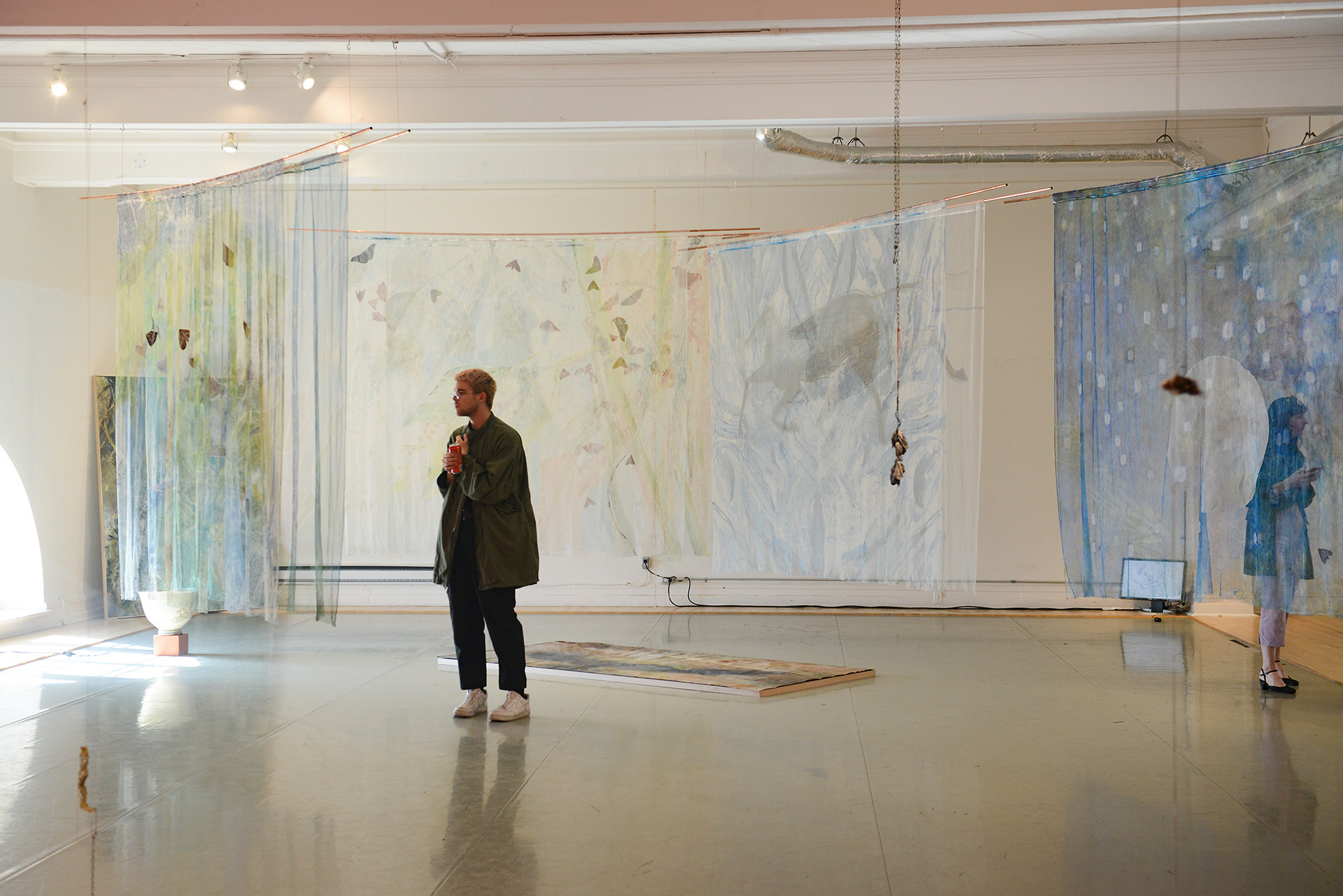Viewers would be forgiven upon entering Art POP’s main exhibition, Tout ce qui arrive, arrive dans les verbes, for thinking that they had come to the wrong room. A set of lockers that line the left wall and a ‘douches/showers’ sign are among the first things to notice in the venue. This exhibition, which ran from Sept. 25 to 29 at Studio Rialto, is part of the visual-arts strand of POP Montreal International Music Festival.
Aside from the unique infrastructure of the space, which was originally a dance studio, the cloths that dominate the west side of the installation are the most eye-catching part of the exhibit. These cloths, like many pieces in the room, evoke natural forms: One appears to display the figure of a pig, the other a face shrouded by butterflies and leaves. Neither work displays the artist’s name, which is true of many pieces in the room.
The event description reads: “We want to construct an art viewing context that makes viewers feel as though they are entering an othered space. Within this, we chose work that humanizes, mystifies […] and divulges and/or withholds elements of these physical spaces.”
The dearth of information and the surprising difficulty of pairing the exhibit’s map with its physical layout spark curiosity as new pieces are discovered and the exhibit is slowly revealed. Behind one curtain is a changing room; although part of the building’s design, this feature of the studio is incorporated subtly into the exhibit, with no clear additions beyond a creaking blue light and a thin layer of condensation present on the floor. Stepping into it feels like walking into a room where you don’t belong.
The event description also reads: “Studio Rialto [is] a former dance studio with its own history of bodies in movement, queerness, and temporality.” This history is apparent in the space’s decor, with antique and found items cluttering the space with little-to-no context provided. Their history as objects may be understood from shared, broader cultural knowledge, but their origins are unknown. Many installations—most of which are strung from the ceiling—appear to have been collected on distant beaches, and include seashells and metal rings.
This natural motif does not clash with the industrial quality of the space itself, but rather heightens it. The presence of seashells, leaves, and other natural objects within the confines of a worn and lived-in industrial space links their histories as objects “of nature” with the studio’s history of being occupied by living bodies. This connection suggests the shared temporality of natural environments and urban constructions. Both capture, contain, and carry their histories within them. This theme is addressed by bio-artist Jacqueline Beaumont’s for luca. Her display features bioplastic breasts hung in glass cases, one containing a lobster.
This odd combination of materials feels strangely natural in the context of the large hall. The crustacean and the plastic are as real as the walls of the studio or the seashells. But it is still unclear how the lobster ended up there, or why. In the same way, the space allows the art to speak for itself, without over-contextualizing or providing rich details of the Studio’s history. But as the exhibition appears and disappears, the space of Studio Rialto itself will persist.
Tout ce qui arrive, arrive dans les verbes ran from Sept. 25–29, at Studio Rialto (5723 Park Avenue) and featured works from Zoe Koke, Sara Maston, Robert Anthony O’halleran, Tommy Ting, Jamie Ross, flora fauna, Julia Autumn, Jacqui Beaumont, Aloë Vrzal, Lucas Regazzi, Sarah Mihara Creagen, Mara Korkola, and XX Files Radio.








